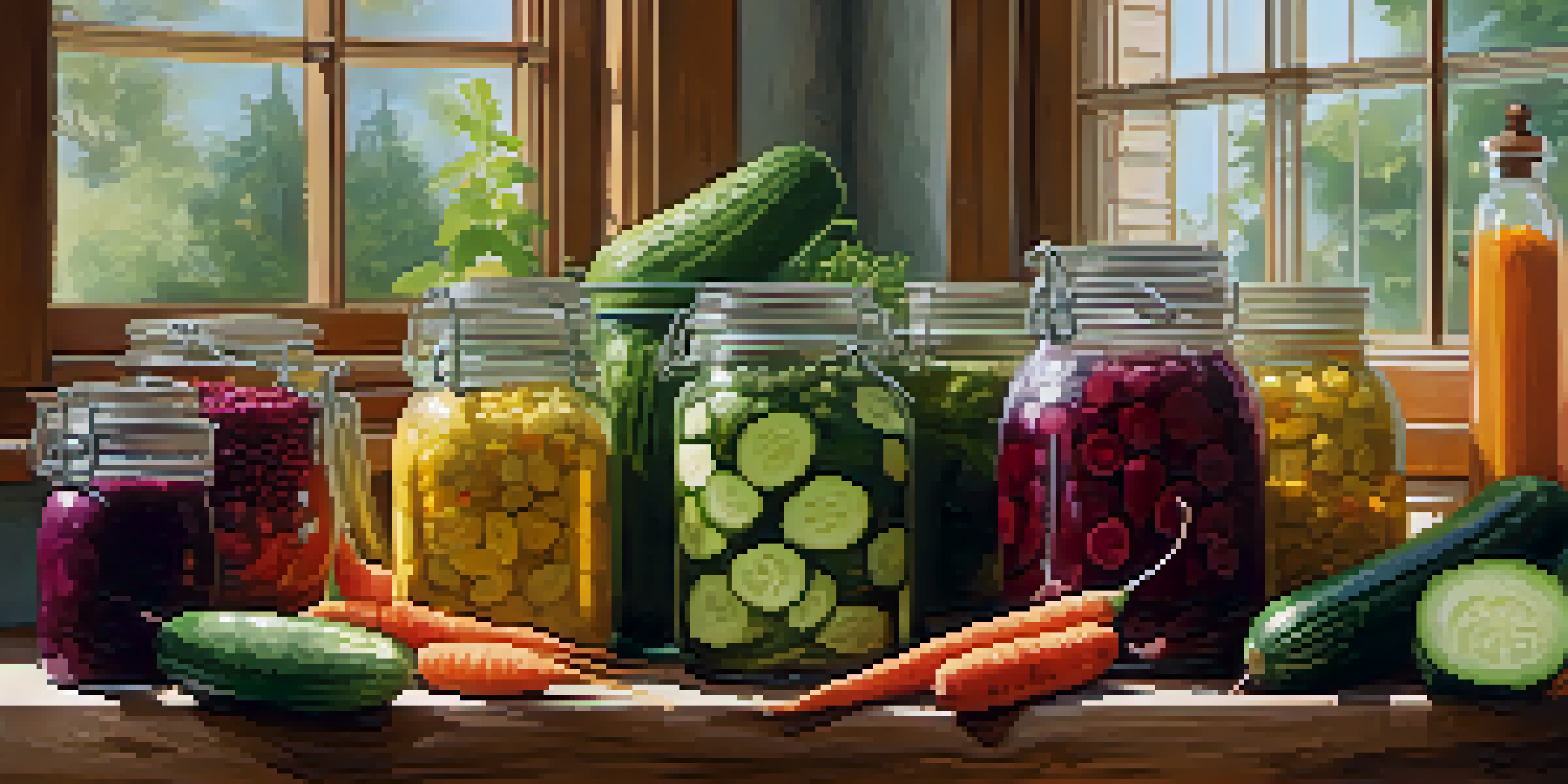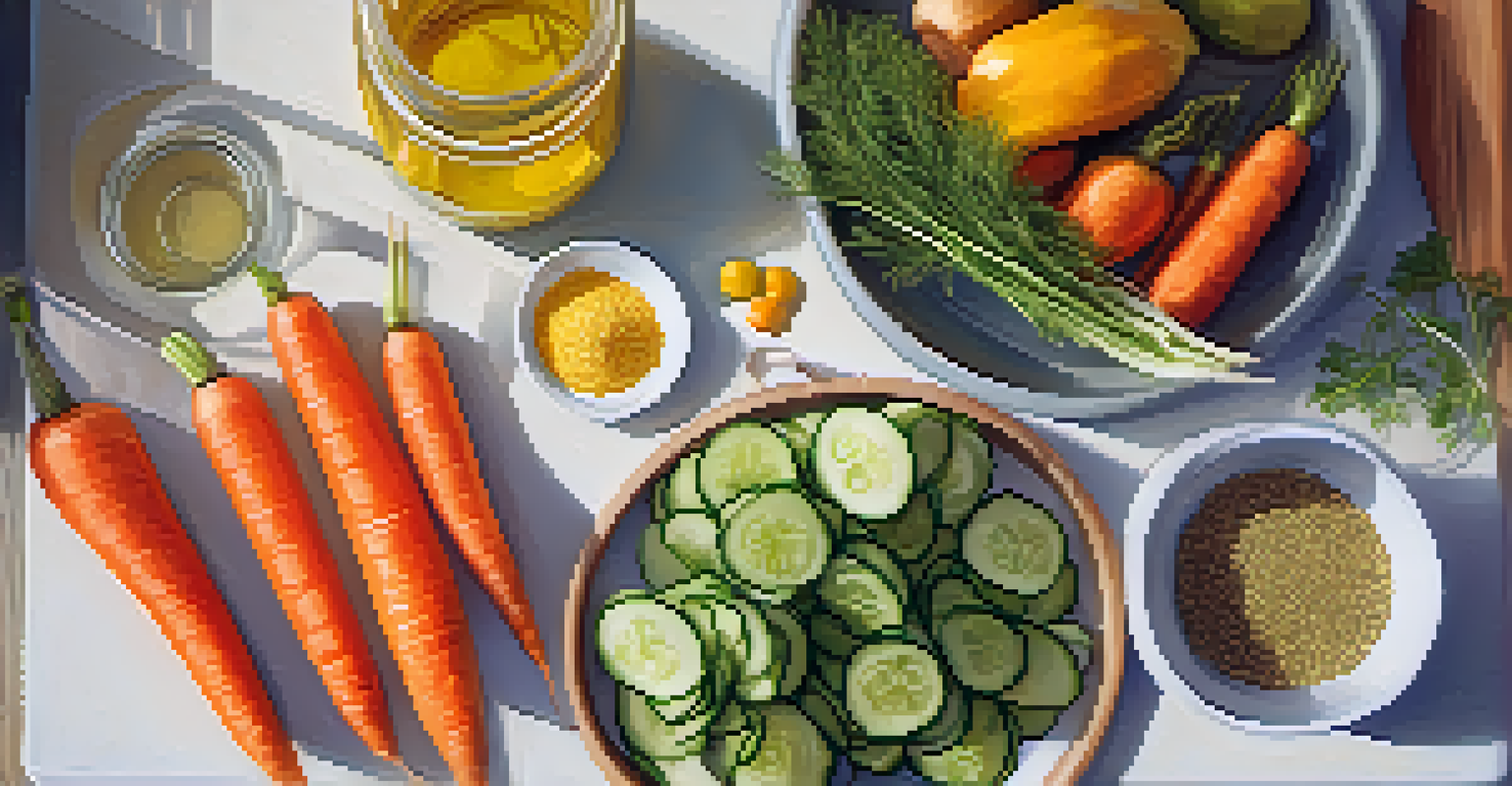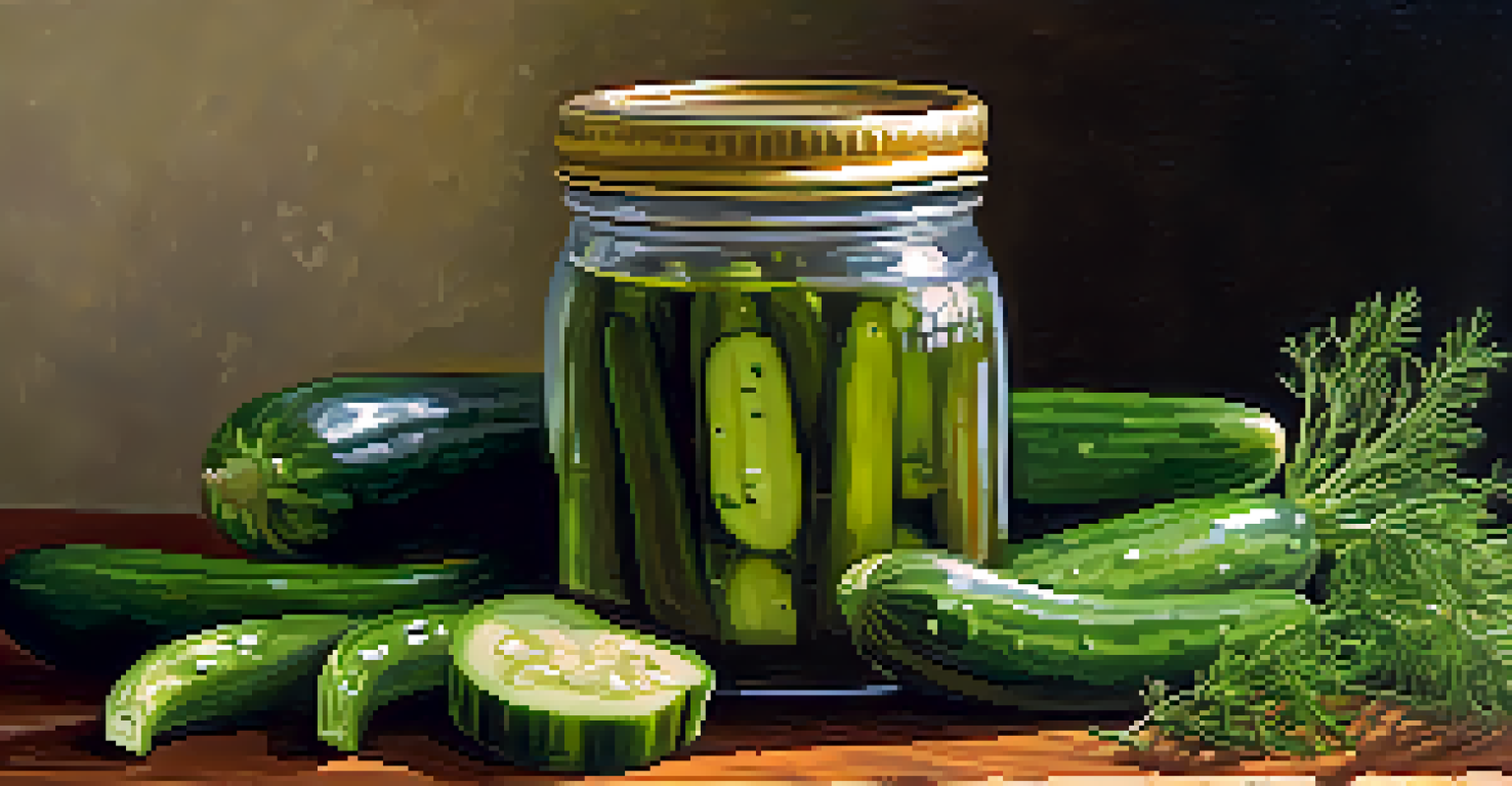Spices and Flavorings in Pickling: A Comprehensive Guide

Understanding the Role of Spices in Pickling
Spices are the heart and soul of pickling, adding depth and complexity to your preserved vegetables. They not only enhance flavor but also contribute to the preservation process. For instance, spices like dill and mustard seeds can infuse your pickles with a unique taste profile that transforms a simple cucumber into a delightful treat.
Spices are the heart and soul of pickling, adding depth and complexity to your preserved vegetables.
When you think of pickling, you might visualize jars full of brine and veggies, but it's the spices that create the magic. They work in harmony with vinegar, salt, and sugar to create a balanced flavor. Imagine a tangy dill pickle: the vibrant notes of dill paired with the sharpness of vinegar create a perfect bite that’s both refreshing and savory.
Moreover, the right combination of spices can cater to individual taste preferences. Whether you like your pickles sweet, spicy, or tangy, there's a spice blend out there for you. Experimenting with spices can lead to exciting new flavors that make your pickles stand out.
Popular Spices Used in Pickling
Some spices have become staples in the pickling world due to their unique flavors and preservation qualities. Dill, for instance, is a classic choice for cucumber pickles, lending a fresh, herbal note that many people adore. Similarly, mustard seeds provide a slight warmth and a hint of bitterness that balances the acidity of the brine.

Other widely used spices include coriander seeds and black peppercorns, which add a subtle depth to the flavor profile. Coriander seeds bring a citrusy sweetness, while black peppercorns introduce a gentle heat that lingers. Together, they create a more complex flavor that can elevate your pickling game.
Spices Enhance Pickling Flavor
Spices are essential for adding depth and complexity to pickled vegetables, transforming simple ingredients into delightful treats.
Don’t forget about garlic and chili flakes! Garlic adds a pungent richness, while chili flakes can bring the heat. These spices not only enhance the taste but also add an aromatic quality that makes your pickles irresistible.
Herbs vs. Spices: What’s the Difference?
While often used interchangeably, herbs and spices serve distinct roles in the culinary world. Herbs typically come from the leafy green parts of plants and are used fresh or dried. On the other hand, spices are derived from other plant parts, such as seeds, roots, or bark, and are usually dried and ground.
Pickling is an adventure in flavor, and the journey is just as delightful as the destination.
In pickling, both herbs and spices play crucial roles. For example, fresh dill is an herb that brightens up the brine, while dried mustard seeds are a spice that adds depth. Understanding this difference can help you choose the right ingredients for your pickling recipes.
Moreover, complementing herbs with spices can create a well-rounded flavor profile. Think of it like a team where each member brings something unique to the table. Together, they can produce a harmonious blend that makes your pickles truly special.
Creating Your Own Pickling Spice Blend
One of the joys of pickling is the ability to customize your spice blend. Start with a base of your favorite spices, such as mustard seeds, coriander, and peppercorns. From there, you can experiment by adding herbs like dill or even spices like allspice to create a unique flavor profile that suits your taste.
Consider the types of vegetables you are pickling, as they can influence your spice choices. For example, a blend that works well with cucumbers may differ from one suited for carrots or beets. Tailoring your blend to complement the specific veggies can enhance the overall taste and experience.
Customize Your Pickling Spice Blend
Creating a personalized spice blend allows for unique flavors that can enhance the taste of specific vegetables.
Don't be afraid to get creative! You can even incorporate ingredients like bay leaves or cinnamon for an unexpected twist. Document your combinations so you can recreate your favorites or make adjustments for future batches.
The Science Behind Flavor Development in Pickling
Pickling is as much a science as it is an art, particularly regarding flavor development. When vegetables are submerged in brine, the spices start to release their essential oils and flavors, infusing the produce with their unique characteristics. This process is known as diffusion, where flavors move from an area of high concentration (the spices) to a lower concentration (the vegetables).
As the pickles sit, the flavors continue to meld and deepen, resulting in a more robust taste over time. This is why many pickles are often better after a few days or weeks in the fridge! The waiting game can be hard, but the payoff is worth it for that burst of flavor.
Understanding this science can help you tweak your recipes for the desired outcome. If you prefer a milder flavor, you might opt for a shorter soaking time, whereas a longer soak can lead to a more intense flavor experience.
Common Mistakes to Avoid When Using Spices in Pickling
While experimenting with spices can be thrilling, there are a few pitfalls to watch out for. One common mistake is using too much spice, which can overpower the natural flavors of the vegetables. Remember, the goal is to enhance, not dominate, the taste. Start with small amounts and adjust as needed to find the perfect balance.
Another mistake is not considering the freshness of your spices. Dried spices lose their potency over time, so it's essential to use fresh or properly stored spices to achieve the best flavor. If your spices have been sitting in the cupboard for ages, it might be time for a refresh.
Avoid Common Pickling Mistakes
To achieve the best flavor in pickling, it's important to avoid using excessive spices, ensure freshness, and taste as you go.
Lastly, don’t forget to taste as you go! Pickling is a personal journey, and your palate should guide you. Sampling the brine can help you decide whether you need more spice, sweetness, or acidity before you seal the jars.
Final Thoughts on Spices and Flavorings in Pickling
In conclusion, spices and flavorings are key players in the pickling process, turning simple vegetables into tantalizing treats. By understanding the roles of different spices, experimenting with your blends, and avoiding common pitfalls, you can create pickles that are uniquely your own.
Remember, pickling is an adventure in flavor, and the journey is just as delightful as the destination. Whether you're a novice or a seasoned pro, the world of spices holds endless possibilities for your pickling projects.

So grab those jars, gather your spices, and start experimenting! With each batch, you'll learn something new and discover the perfect blend that makes your taste buds dance.